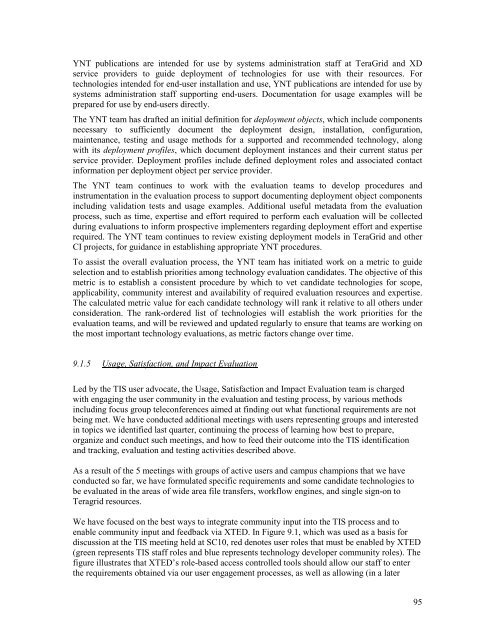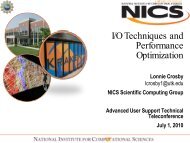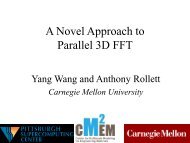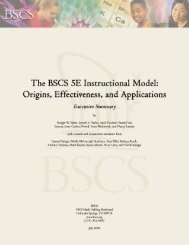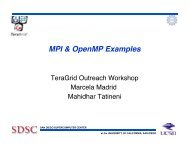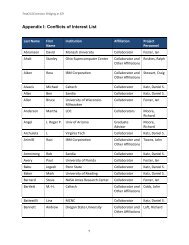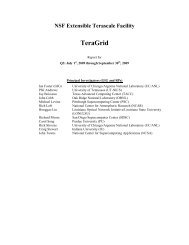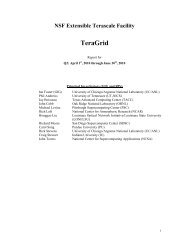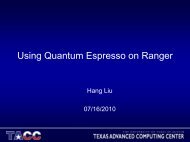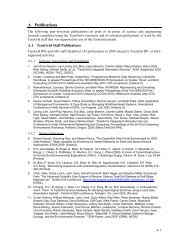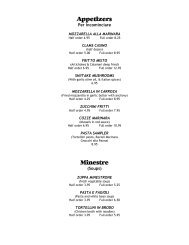TGQR 2010Q4 Report.pdf - Teragridforum.org
TGQR 2010Q4 Report.pdf - Teragridforum.org
TGQR 2010Q4 Report.pdf - Teragridforum.org
Create successful ePaper yourself
Turn your PDF publications into a flip-book with our unique Google optimized e-Paper software.
YNT publications are intended for use by systems administration staff at TeraGrid and XD<br />
service providers to guide deployment of technologies for use with their resources. For<br />
technologies intended for end-user installation and use, YNT publications are intended for use by<br />
systems administration staff supporting end-users. Documentation for usage examples will be<br />
prepared for use by end-users directly.<br />
The YNT team has drafted an initial definition for deployment objects, which include components<br />
necessary to sufficiently document the deployment design, installation, configuration,<br />
maintenance, testing and usage methods for a supported and recommended technology, along<br />
with its deployment profiles, which document deployment instances and their current status per<br />
service provider. Deployment profiles include defined deployment roles and associated contact<br />
information per deployment object per service provider.<br />
The YNT team continues to work with the evaluation teams to develop procedures and<br />
instrumentation in the evaluation process to support documenting deployment object components<br />
including validation tests and usage examples. Additional useful metadata from the evaluation<br />
process, such as time, expertise and effort required to perform each evaluation will be collected<br />
during evaluations to inform prospective implementers regarding deployment effort and expertise<br />
required. The YNT team continues to review existing deployment models in TeraGrid and other<br />
CI projects, for guidance in establishing appropriate YNT procedures.<br />
To assist the overall evaluation process, the YNT team has initiated work on a metric to guide<br />
selection and to establish priorities among technology evaluation candidates. The objective of this<br />
metric is to establish a consistent procedure by which to vet candidate technologies for scope,<br />
applicability, community interest and availability of required evaluation resources and expertise.<br />
The calculated metric value for each candidate technology will rank it relative to all others under<br />
consideration. The rank-ordered list of technologies will establish the work priorities for the<br />
evaluation teams, and will be reviewed and updated regularly to ensure that teams are working on<br />
the most important technology evaluations, as metric factors change over time.<br />
9.1.5 Usage, Satisfaction, and Impact Evaluation<br />
Led by the TIS user advocate, the Usage, Satisfaction and Impact Evaluation team is charged<br />
with engaging the user community in the evaluation and testing process, by various methods<br />
including focus group teleconferences aimed at finding out what functional requirements are not<br />
being met. We have conducted additional meetings with users representing groups and interested<br />
in topics we identified last quarter, continuing the process of learning how best to prepare,<br />
<strong>org</strong>anize and conduct such meetings, and how to feed their outcome into the TIS identification<br />
and tracking, evaluation and testing activities described above.<br />
As a result of the 5 meetings with groups of active users and campus champions that we have<br />
conducted so far, we have formulated specific requirements and some candidate technologies to<br />
be evaluated in the areas of wide area file transfers, workflow engines, and single sign-on to<br />
Teragrid resources.<br />
We have focused on the best ways to integrate community input into the TIS process and to<br />
enable community input and feedback via XTED. In Figure 9.1, which was used as a basis for<br />
discussion at the TIS meeting held at SC10, red denotes user roles that must be enabled by XTED<br />
(green represents TIS staff roles and blue represents technology developer community roles). The<br />
figure illustrates that XTED’s role-based access controlled tools should allow our staff to enter<br />
the requirements obtained via our user engagement processes, as well as allowing (in a later<br />
95


